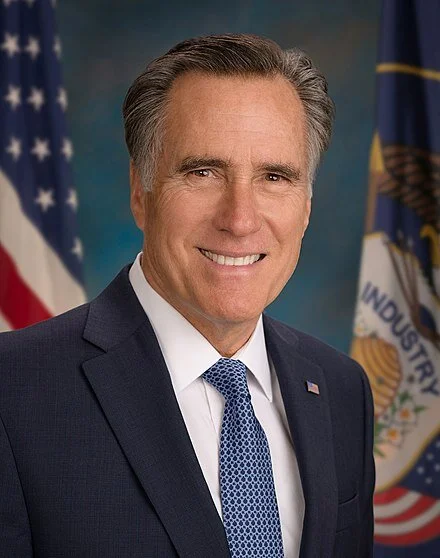
Romney on Mass. gun laws
Mitt Romney
“We do have tough gun laws in Massachusetts. I support them. I won't chip away at them. I believe they help protect us and provide for our safety.’’
Mitt Romney, Republican governor of Massachusetts, 2003-07, and now U.S. senator from Utah. When a Bay Stater, he lived in Belmont, a very affluent western suburb of Boston.
The grand Romanesque Belmont Town Hall.
David Warsh: The accidental president
Cast your mind back a couple of years ago, to the six weeks when the presidential campaign of 2016 was gearing up. Lukewarm Jeb Bush decided at Thanksgiving with his family in 2014 to throw his hat in the ring. Suddenly in January Mitt Romney jumped into the race – for all of three weeks. What I’ve heard since from various insiders is that his children were reluctant and his fundraisers told him no. Had his backers pushed ahead, there’s a good chance that Romney would be president-elect today.
The 2016 election was a fluke, the result of a desire on the part of the leaders of both parties to refight the election of 1992, when Bill Clinton surprised George H. W. Bush and H Ross Perot got 19 percent of the popular vote (but no votes in the Electoral College).
The shock to blue-collar workers then was trade with Mexico and Japan; in the last 10 years, it was China. Bush faded early. Clinton carried 24 years’ worth of baggage. So splintered was the Republican Party that 17 candidates declared. This time the outsider slipped in – a 70-year-old billionaire willing and able to flout every convention.
Staffing up is now drawing most of the attention, but getting to know Trump’s closest advisers, Jared Kushner and Stephen Bannon is even more fundamental. More than a year ago, Bannon was the subject of a prescient article by Joshua Green in Bloomberg BusinessWeek. It revealed, among other things, that Bannon was the force behind Clinton Cash: The Untold Story of How and Why Foreign Governments and Businesses Helped Make Bill and Hillary Clinton Rich (HarperCollins, 2015).
That plainly partisan account, by Peter Schweizer, a former George W. Bush speechwriter, nevertheless succeeded in calling widespread attention to the novel institution that was the Clinton Foundation. Aroused by the book, rogue FBI agents, past and present, forced Director James Comey to issue his controversial letters to congressional committee chairmen shortly before the election. (His dilemma was widely misunderstood.)
Similarly, it is pretty widely recognized by now that it was Jared Kushner, Trump’s son-in-law and close counselor, who ran off from the transition team New Jersey Gov. Chris Christie. There was Bridgegate, of course. Less noticed was the fact that as U.S. attorney for New Jersey 10 years before, eager to rise in Republican ranks, Christie prosecuted Kushner’s father, a real estate developer and prominent Democrat, for income-tax evasion.
Kushner remained fiercely loyal to his father throughout, flying down Sundays to Alabama for more than a year to visit his father in federal prison. Still less well known is the nature of the prosecution. Here’s the way that Gary Silverman described it in the Financial Times:
“Not only had the elder Kushner admitted to filing false tax reports, he also acknowledged hiring a prostitute to seduce his sister’s husband so the encounter could be filmed by private detectives in his employ. The tape was then sent to his brother-in-law and sister’s home in an ill-fated attempt to stop them from helping prosecutors.’’
So much for meeting the top guys inside the Trump White House. Over the next few weeks, there will be a steady stream of news about nominations and appointments. After Jan. 20, the next four years will be a constant tussle between Trump and the “elite’’ he despises — the press and, of course, mainstream economists of both parties in particular. Martin Feldstein and Lawrence Summers have already weighed in. Expect appointments to the Federal Reserve’s Board of Governors to give him the most trouble. After that come, in no particular order, foreign relations, national defense, domestic policing, health care, Social Security, tax reform, global warming and trade.
Only slightly less interesting is the contest for leadership of the Democratic Party. Tim Ryan, 43, of Ohio, announced he would challenge Minority Leader Nancy Pelosi, 76, of California, for the top Democratic leadership spot in the House. The eight-term congressman was at first judged to be a longshot – Pelosi has led Congressional Democrats for nearly fourteen years, longer than former House Speaker Thomas P. “Tip” O’Neill Jr.
But Ryan has succeeded in delaying a vote. In fact the choice would seem to be a no-brainer. The Democrats have lost 60 seats from the majority they held in 2009. As WBUR broadcaster Jack Beatty observed, the average home price in Ryan’s heavily Democratic district, which includes Akron and Youngstown, is around $50,000; in the San Francisco district that Pelosi represents, it’s $1.1 million. Pelosi’s net worth is more than $100 million; Ryan’s is around $200,000 A vote is scheduled for Nov. 30.
Donald J. Trump is certainly smart enough to be president, but in one respect he is especially ill-equipped for the job’s most important requirement – that of narrator-in-chief. It always seemed likely to me that had Hillary Clinton been elected, she would serve only one term. My guess is the same of Trump. Should he choose not to run, the GOP has Mike Pence, Paul Ryan, Ben Sasse, Tom Cotton, and, yes, Ted Cruz. Competitive Democratic candidates have yet to emerge. Sooner or later, calm opposition to the accidental president can be expected to put the Democrats back in the White House. The redistricting game takes longer.
David Warsh, a veteran financial journalist and economic historian, is proprietor of Somerville, Mass.-based economic principals.com, where this first ran.

